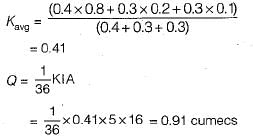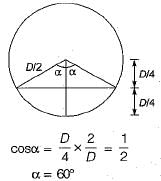Test: Sewage Collection - 1 - Civil Engineering (CE) MCQ
10 Questions MCQ Test - Test: Sewage Collection - 1
The liquid wastes originating from residential and industrial buildings, are collectively called:
| 1 Crore+ students have signed up on EduRev. Have you? Download the App |
An sewer pipe carrying sewage from a building to the point of its immediate disposal, is called.
The ratio of maximum daily sewage flow to the average daily sewage flow for sewer mains of 0.5 to 1 m diameter, is generally taken as
The ratio of minimum hourly flow to the average flow of sewage, is
The value of the coefficient of runoff for perfectly impervious areas, tend to:
The drainage discharge of a town of 16 hectares area, consisting of 40% hard paved (k = 0.8), 30% unpaved (k = 0.20), and remaining as wooded (k = 0.1), with a max. rain intensity of 5 cm/hr, would be computed by Rational formula, as equal to
In a circular sewer of dia D, if the depth of flow is D/4, the wetted perimeter will be equal to





















